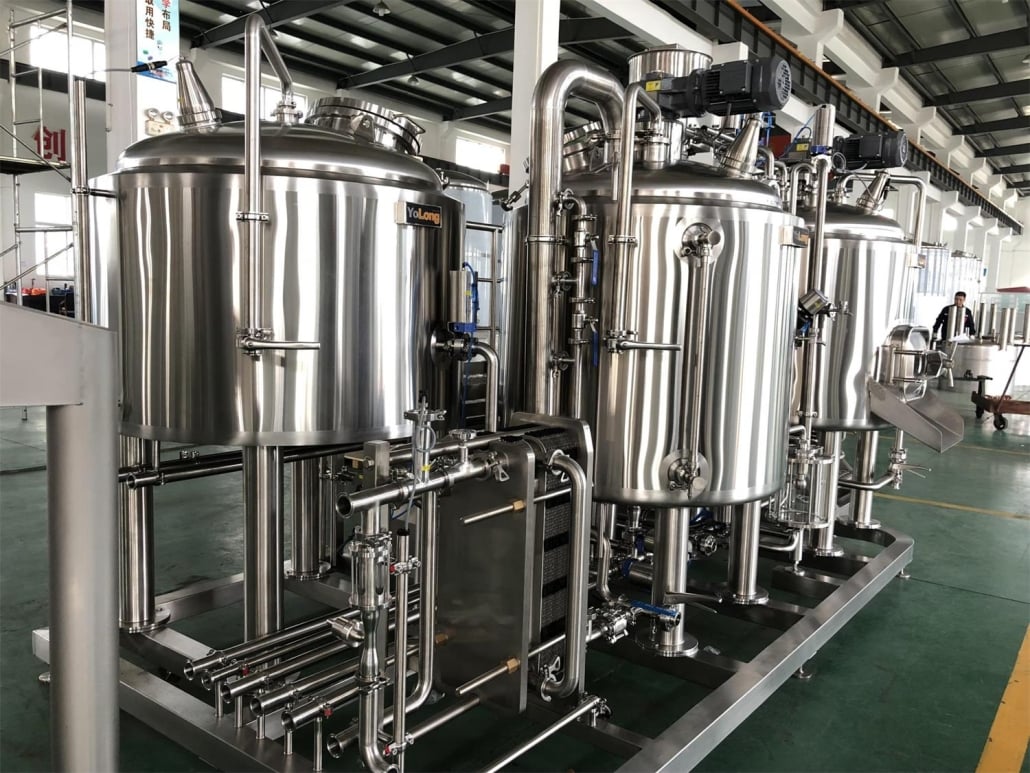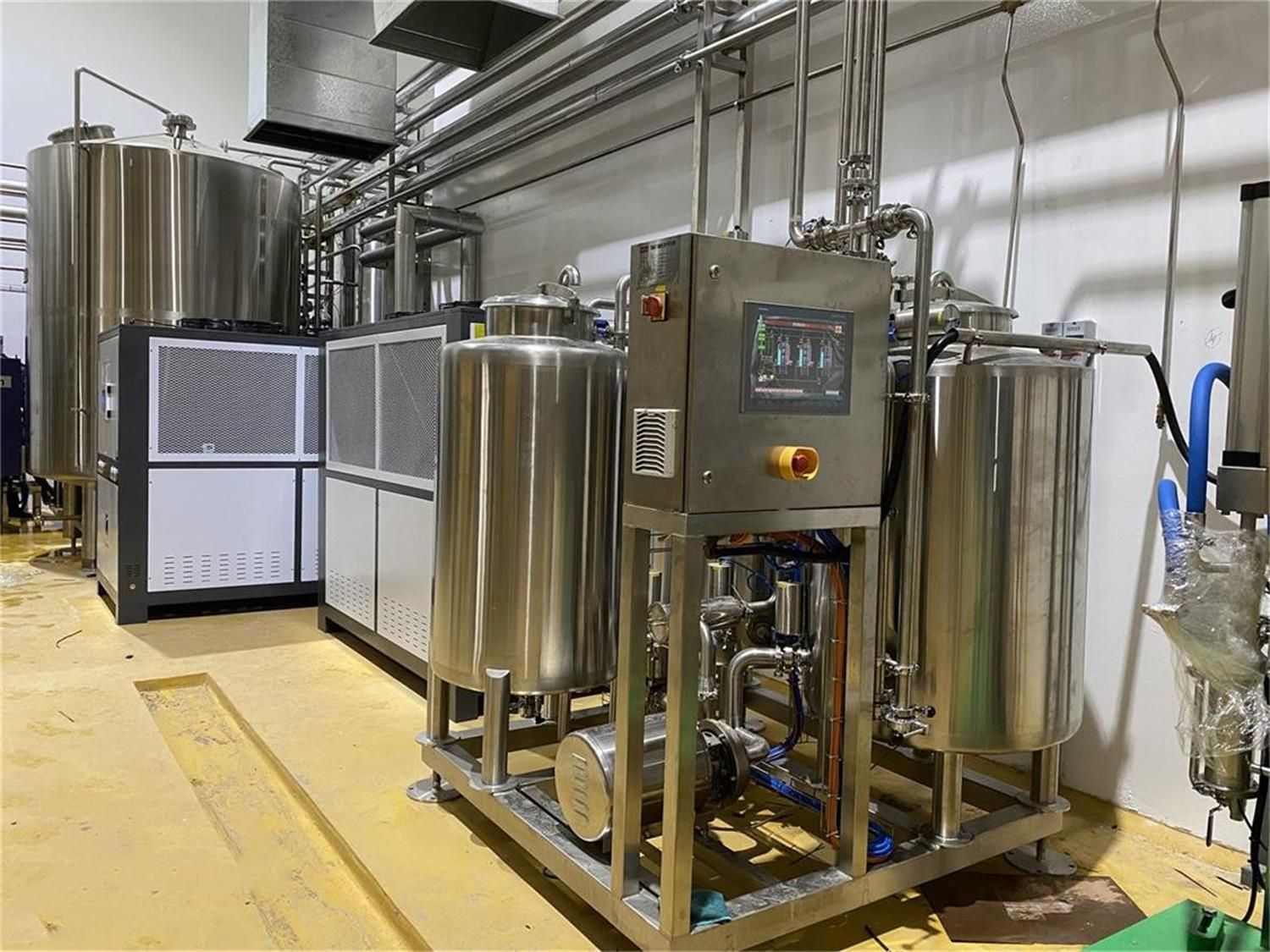Overview of Conical Fermenters
Conical fermenters, sometimes referred to as uni-tanks or uni-vessels, are a type of fermentation tank used in brewing beer and other alcoholic beverages. They get their name from their conical shape, with a broad base that tapers to a narrow top.
Key Features and Benefits
Some of the main features and benefits of conical fermenters include:
- Efficient design allows for combined fermentation and conditioning in one tank
- Cone-shaped bottom makes it easy to collect yeast and trub
- Integrated cooling jackets or glycol coils for temperature control
- Sample valves for taking hydrometer readings and testing beer
- Can modify tank pressure for fermentation, carbonation, transfers
- Available in different materials like stainless steel and plastic
- Range of sizes from 3 gallon homebrew models up to 5000 gallon industrial scale
- Lower risk of oxidation and contamination compared to transferring between multiple vessels

Equipment Guide – Conical Fermenter Types
| Type | Description | Typical Uses |
|---|---|---|
| Plastic Conical Fermenters | Inexpensive, lightweight, translucent plastic allowing visibility. Available in 3-15 gallon sizes. | Homebrewing, pilot systems |
| Stainless Steel Uni-tanks | Commercial-grade stainless steel conicals ranging from 30-5000+ gallons. Jacketed, pressure-rated. | Pro and commercial breweries |
| Half-Barrel Conicals | ~15 gallon stainless mini-conicals designed for homebrewers. Combine features of uni-tanks in a smaller format. | Advanced homebrewing |
| Open Top vs Closed Top | Open top models have large openings for loading fruit, dry hops. Closed top have smaller ports. | Breweries choose based on process requirements |
| Cooling Options | Glycol/recirculating chilling | Temperature control during fermentation |
| Pressure-rated | Rated for pressurization | Carbonation, transfers under pressure |
Conical Fermenter Sizes
Conical fermenters are available in a wide range of volumes to meet different brewing production requirements:
| Size | Capacity | Typical User |
|---|---|---|
| 3-30 gallons | Homebrew batches up to ~10 barrels | Homebrewers and nanobreweries |
| 30-300 gallons | Pilot batches up to ~60 barrels | Pilot systems, pub breweries |
| 500-5000+ gallons | Full brew lengths for production breweries | Production craft breweries |
| 3000-30000+ gallons | Large batch fermentation | Industrial breweries |
The dimensions, height, and footprint increase proportionally with capacity based on the conical design. Options are available for tank customization.
Conical Fermenter Design and Layout
Conical fermenters have an internal cone-shaped bottom and cylindrical top half. This shape allows sedimentation of yeast and trub during fermentation and conditioning.
Key design elements and parts of a conical fermenter include:
- Cone base tapering to collection ball valve
- Cylindrical upper tank with dish or domed lid
- Sample valve, sight glass, air vent ports
- Integrated cooling jackets or glycol in/out ports
- Pressure rating for pressurization
- Solid or screen false bottom to separate trub
- Sanitary fittings – valves, ports, connectors
- Stand/frame with adjustable feet
Many custom options are available:
- Manways for access
- Spray balls/nozzles
- Integrated heaters
- Variable volume marker
- Casters for mobility
- Ladder and platform for tank access
Choosing a Conical Fermenter Supplier
Reputable conical fermenter manufacturers and suppliers include:
| Company | Location | Price Range |
|---|---|---|
| Ss Brewtech | USA | 80-9000 |
| Spike Brewing | USA | 90-500 |
| Blichmann Engineering | USA | 999 |
| Uni-Tank | Canada | 9-700 |
| ABE/Maverick | USA | 999 |
| Rolec | UK | 999 |
| Paco/Andino | Spain | 9-9999 |
Key factors when selecting a conical fermenter supplier:
- Budget – Prices range widely depending on size and features
- Quality and durability – Stainless steel thickness, welding, finishing
- Lead time – Production time and availability
- Customization options – Support for special options
- Customer service – Responsive support representatives
Be sure to get multiple quotes before purchasing as prices can vary significantly.
Installing and Operating Conical Fermenters
Proper installation and operation ensures safety, efficiency and beer quality:
- Review manufacturer instructions for setup and cleaning requirements
- Level and secure tank on stand allowing access
- Connect cooling and glycol lines per spec
- Attach sanitary fittings; check for leaks under pressure
- Test sample valves and ports during cleaning cycles
- Monitor fermentation temperature and make adjustments
- Use calibrated yeast pitch rates based on batch size
- Ensure stable fermentation before crash cooling or transferring
Conical Fermenter Maintenance
Routine maintenance is required for longevity and proper performance:
- Inspect seals and gaskets; replace worn parts
- Verify accurate pressure gauges and sensors
- Describe cleaning procedures and schedules in SOPs
- Follow passivation procedures after wetted surface exposure
- Check sample valves and ports for signs of build up
- Monitor cooling system functionality and glycol concentration
Pros and Cons of Conical Fermenters
| Pros | Cons |
|---|---|
| Efficient fermentation and conditioning in one vessel | More expensive upfront cost than cylindrical tanks |
| Compact footprint conserves space | Larger units require hoists or cranes for handling |
| Easy collection of yeast and trub | Additional training needed to leverage features |
| Flexible pressurization capabilities | Requires more planning for cleaning and maintenance |
| Lower risk of oxidation and contamination | Potential for foaming with some beer styles |

Choosing Between Conical and Cylindrical Fermenters
Conical Fermenters are best suited for:
- Breweries with space constraints necessitating a compact design
- Beers requiring yeast harvesting like lagers and high-gravity beers
- automated or semi-automated brewhouses with integrated transfers
- Budget is less constrained and quality is top priority
Cylindrical Fermenters tend to be preferable when:
- Cost savings is key priority
- Facility has space for multiple vessels
- Brewing ale styles not requiring yeast harvesting
- Manual brewing process without integrated automation
FAQ
What size conical fermenter should I choose?
Choose a size approximately 1.5-2X your target batch size to allow sufficient headspace for active fermentation.
Should I get a cooled vs non-cooled conical?
Temperature control is critical for quality beer, so a cooled/glycol jacketed conical is highly recommended unless you already have a glycol system plumbed externally.
How many turns/openings are needed on sample valves?
Look for 3-4 turns or openings needed to fully open sample valves. This slows valve opening to prevent violent outrush of beer and foaming.
What material should I choose – stainless or plastic?
For commercial or serious homebrewing look for stainless steel conicals which are more durable, pressure capable, and sanitize better. Plastics can scratch over time.
Any suggestions on conical fermenter manufacturers?
Top manufacturers include Ss Brewtech, Spike, Blichmann, Rolec, Uni-tanks, and Paco based on reputation and customer experiences in homebrew forums. Always verify certifications.
Frequently Asked Questions (FAQ)
1) What cone angle is optimal for Conical Fermenters?
- A 60° cone (half-angle ~30°) is common; it compacts yeast well while allowing reliable racking. Steeper cones aid harvest; shallower cones risk trub carryover.
2) How much headspace should I leave in a pressure-capable conical?
- Target 15–30% headspace for ales (top-cropping strains closer to 30%), 10–20% for lagers. Insufficient headspace increases PRV lifts and blow-off losses.
3) Do I need a pressure-rated uni-tank for spunding and carbonation?
- Yes. Choose vessels rated ≥1.5–2.0 bar (15–30 psi) with certified PRV and vacuum relief. Non-rated plastics or thin-walled steel are unsafe for pressure fermentation.
4) What internal finish (Ra) should I specify?
- Aim for Ra ≤0.6–0.8 μm with proper passivation. Smoother surfaces reduce biofilm formation and shorten CIP time.
5) What ports are “must-haves” for modern conicals?
- Top CIP with rotary spray ball, thermowell, sample valve with purge, racking arm, carb stone port, 1–2 jacket zones, pressure/vacuum relief, and a large manway for inspection.
2025 Industry Trends for Conical Fermenters
- Oxygen control by design: more conicals ship with inert gas purge manifolds, low-DO valves, and DAW-compatible ports.
- Smart sensing: integrated temp/pressure/level DO ports and Bluetooth gateways for cellar-wide monitoring.
- Efficiency-first finishes: Ra ≤0.6 μm internals and improved spray devices cutting CIP time 15–30%.
- Energy optimization: thicker insulation and multi-zone jackets to reduce glycol load in warm climates.
- Small-scale pressure fermentation: growth of 5–15 gal pressure-rated stainless conicals for home and pilot systems.
Conical Fermenter Benchmarks (2024–2025)
| Metric | Typical Range | 2025 Best Practice Target | Notes / Sources |
|---|---|---|---|
| Working pressure (uni-tanks) | 1.0–1.5 bar | 1.5–2.0 bar | Supports spunding/carbonation |
| Internal surface roughness (Ra) | 0.8–1.2 μm | ≤0.6–0.8 μm | Faster CIP; less biofilm |
| CIP cycle time per tank | 45–75 min | 30–50 min | Rotary spray ball + validated flow |
| Packaged DO (ppb) | 30–80 | ≤30 (draft ≤20) | ASBC methods |
| Insulation thickness (shell/cone) | 50–80 mm | 80–100 mm | Cuts glycol energy use |
| Brite-to-filler hose length | 10–25 m | ≤10 m | Lower O2 pickup/foam |
Authoritative sources:
- Brewers Association (cellar/CIP/sustainability): https://www.brewersassociation.org/
- ASBC Methods of Analysis (DO, QA): https://www.asbcnet.org/
- EHEDG hygienic design guidelines: https://www.ehedg.org/
Latest Research Cases
Case Study 1: Spunding and Closed Transfer on 30 bbl Conicals (2025)
Background: Regional brewery reported oxidative staling in hoppy SKUs at 90 days.
Solution: Implemented spunding (0.8–1.0 bar) in pressure-rated conicals, CO2-purged hoses/valves, and DO checks at brite and filler inlet.
Results: Packaged DO dropped from 52–70 ppb to 18–26 ppb; shelf life extended ~60 days at 20°C; purchased CO2 reduced 20% due to natural capture.
Case Study 2: Surface Finish Upgrade Reduces CIP Time (2024)
Background: Older conicals (Ra ~1.2 μm) required long CIP and saw intermittent ATP fails after dry-hopping weeks.
Solution: Replaced two tanks with Ra ≤0.6 μm uni-tanks, added rotary spray balls and conductivity/temperature-controlled CIP.
Results: CIP time cut 30%; caustic use down 22%; ATP fails <1% of swabs for 6 months; improved tank availability increased monthly cellar turns by 0.3.
Expert Opinions
- Dr. Tom Shellhammer, Professor of Fermentation Science, Oregon State University
“Cone geometry and oxygen management around conicals heavily influence yeast performance and flavor stability—keep transfers closed and surfaces clean.” - John Mallett, Brewing Operations Expert; author of “Malt”
“Specify the right ports—PRV, vacuum relief, racking arm, sample valve you can sanitize—and validate your CIP. Good conical details prevent bad beer.” - Ashton Lewis, Technical Support Director, BSG
“Trend DO, temperature, and pressure. Conical Fermenters become predictable when you monitor the variables that drive fermentation and pickup.”
Practical Tools/Resources
- Brewers Association cellar/CIP and sustainability resources: https://www.brewersassociation.org/
- ASBC Methods (DO, CO2, microbiology, sensory): https://www.asbcnet.org/
- EHEDG guidance on hygienic tank design and validation: https://www.ehedg.org/
- DOE Better Plants energy tools for process optimization: https://www.energy.gov/
- Vendor technical notes (GEA, Alfa Laval, Pentair) on spray devices, jackets, and passivation
Last updated: 2025-08-29
Changelog: Added focused FAQs, 2025 trends with benchmark table, two conical-focused case studies on spunding/closed transfer and surface finish/CIP, expert viewpoints, and vetted resources.
Next review date & triggers: 2026-02-28 or earlier if BA/ASBC/EHEDG update DO/CIP guidance, new PRV/vacuum standards are issued, or packaged DO exceeds 30 ppb for two consecutive audits.
Share this entry
Interested in learning more about Brewing Systems including additional details and pricing information? Please use the form below to contact us!
YOLONG BREWERY EQUIPMENT FAQS
- Commercial Brewery / Craft Brewery / Microbrewery / Nanobrewery
- What is The Difference Between Craft Beer and Industrial Beer?
- The Bespoke Differences In Custom Brewing Systems
- Everything You Need to Know About Kettle Souring
- How to Choose Brewing Equipment for Your business?
- How To Choose The-Best Partner To Build Your Commercial Microbrewing System?
- Two Detection Sensors That You Need To Use In Your Brewhouse System
- Remote Control Applications in Brewing Equipment/How does it work?
- How To Clean Your Brand New Brewery Tanks?

